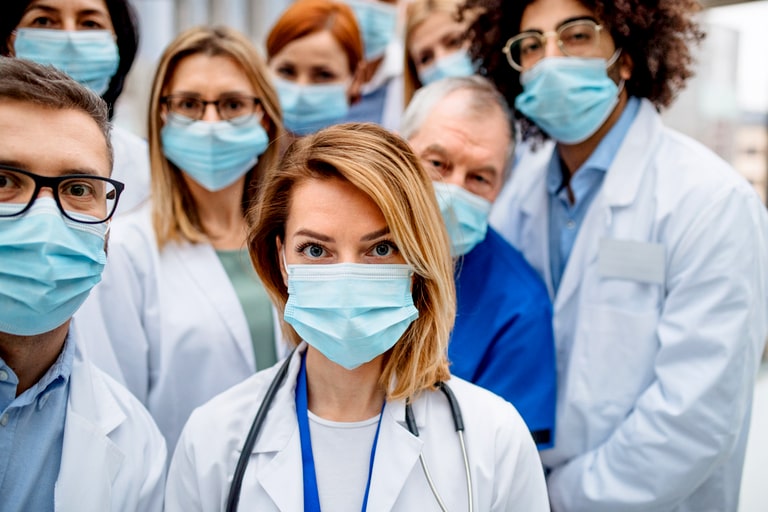By Seth J. Gillihan, Clinical Psychologist, University of Pennsylvania
A recent study released by the Centers for Disease Control and Prevention (CDC) revealed some important trends in how the coronavirus is transmitted. But some have focused on an easily misunderstood point in the study, and have missed the more important takeaways.
The researchers compared 154 adults with a positive COVID test result to 160 who tested negative. They found important differences between the two groups, including:
- Close contact with someone known to have COVID: Those with a positive test were three times as likely to have had close contact (42 percent vs. 14 percent).
- Contact with a family member: More than half (51 percent) of those positive for COVID had close contact with a family member with COVID, vs. 22 percent in the control group.
- Dining in a restaurant: Those with COVID were significantly more likely than those without to have eaten in a restaurant: 41 percent vs. 28 percent.
- Being in a bar or restaurant where others weren’t wearing masks/social distancing: Among those who went to bars, for example, 85 percent of those with COVID reported being in these higher-risk settings, vs. 25 percent of those without COVID.
It’s unsurprising that having close contact with someone with COVID raises the risk of transmission. The more important points from this study are that dining at a restaurant significantly raises the risk of contracting COVID, and that transmission appears more likely when fewer people are wearing masks or social distancing at bars or restaurants.
However, a different story has emerged from some discussions of this report—suggesting the opposite conclusions from what the study found. Here’s the finding that is easy to misinterpret:
Among those with COVID, 85 percent reported wearing a mask “often” or “always.”
That may not sound like good news for masks. Here are incorrect ways to interpret that finding:
- 85 percent of people who wear masks will test positive for COVID. (False)
- Masks do little to prevent the spread of COVID. (False)
- People with masks are actually more likely to contract COVID. (False)
Just to be clear, each of those conclusions would be false. But it’s easy to see how people could make those mistakes. An analogy might clarify why those interpretations are incorrect.
Imagine a study of people who were injured in car accidents versus those who were not. One of the study questions was about wearing a seat belt. The study found that 85 percent of those injured reported wearing a seat belt often or always. Can we conclude that seat belts are ineffective?
Obviously not. We know that seat belts can only lower the risk—they’re not 100 percent effective. In the same way, face masks are not 100 percent effective, but they’re an important way to lower the risk of COVID transmission.
Additionally, we would understand that the study doesn’t show that 85 percent of those who wear seat belts wind up injured. That would be a reversal of the actual finding—that among those who were injured, 85 percent often or always wore seat belts.
It can take some careful thought to distinguish between those two scenarios, but they couldn’t be more different. One asks, “What percentage of people who wear seat belts will be injured in an accident?” The other asks, “What percentage of people who are injured in an accident wear seat belts?”
The answers to those questions are likely to be quite different. Even if everyone who is injured in an accident is wearing a seat belt, we can’t conclude that seat belts don’t work. We would have to know if those who wear seat belts are less likely than those who don’t to be injured in an accident.
In the same way, these two questions are not at all the same:
- What percentage of those who wear masks will contract COVID?
- What percentage of those who contact COVID wear masks?
Even if 100 percent of those who get COVID were wearing masks, masks would still be a good recommendation if fewer people who wear them get COVID. It may seem like a subtle point, but it’s crucial to understand the difference.
Furthermore, we don’t know if those injured were wearing a seat belt at the time of the accident. In the same way, we don’t know if those who contracted COVID were wearing masks when they caught the virus. The data suggest that many may have caught it at a bar or restaurant, where presumably their masks were down at least part of the time (in order to eat or drink).
Finally, we would need to know about other behaviors that might distinguish between the two groups in the car crash study. In this hypothetical study, we find that those who were injured were three times more likely to be traveling at speeds over 90 miles per hour. Based on this finding, we would understand that the group of injured individuals were more likely to engage in high-risk behaviors, and ones that make seat belts less effective.
In the same way, this CDC study shows that those with COVID were more likely to be exposed to high-risk situations, including close contact with individuals with COVID and settings where fewer people were wearing masks and social distancing.
This study is itself a good case study in how statistics can be easy to misinterpret, even with the best of intentions. It also points to the importance of turning to reliable sources for making sense of scientific findings.
Seth J. Gillihan is clinical psychologist, author of The CBT Deck, co-author of A Mindful Year, and host of the Think Act Be podcast. He is also clinical assistant professor of psychology in the Psychiatry department at the University of Pennsylvania
References
Fisher KA, Tenforde MW, Feldstein LR, et al. Community and Close Contact Exposures Associated with COVID-19 Among Symptomatic Adults ≥18 Years in 11 Outpatient Health Care Facilities — United States, July 2020. MMWR Morb Mortal Wkly Rep 2020;69:1258–1264. DOI: http://dx.doi.org/10.15585/mmwr.mm6936a5.
Note: The views expressed in this article are the author’s, and not the position of Intellectual Dose, or iDose (its online publication). This article originally appeared in Psychology Today and has been reprinted with permission



